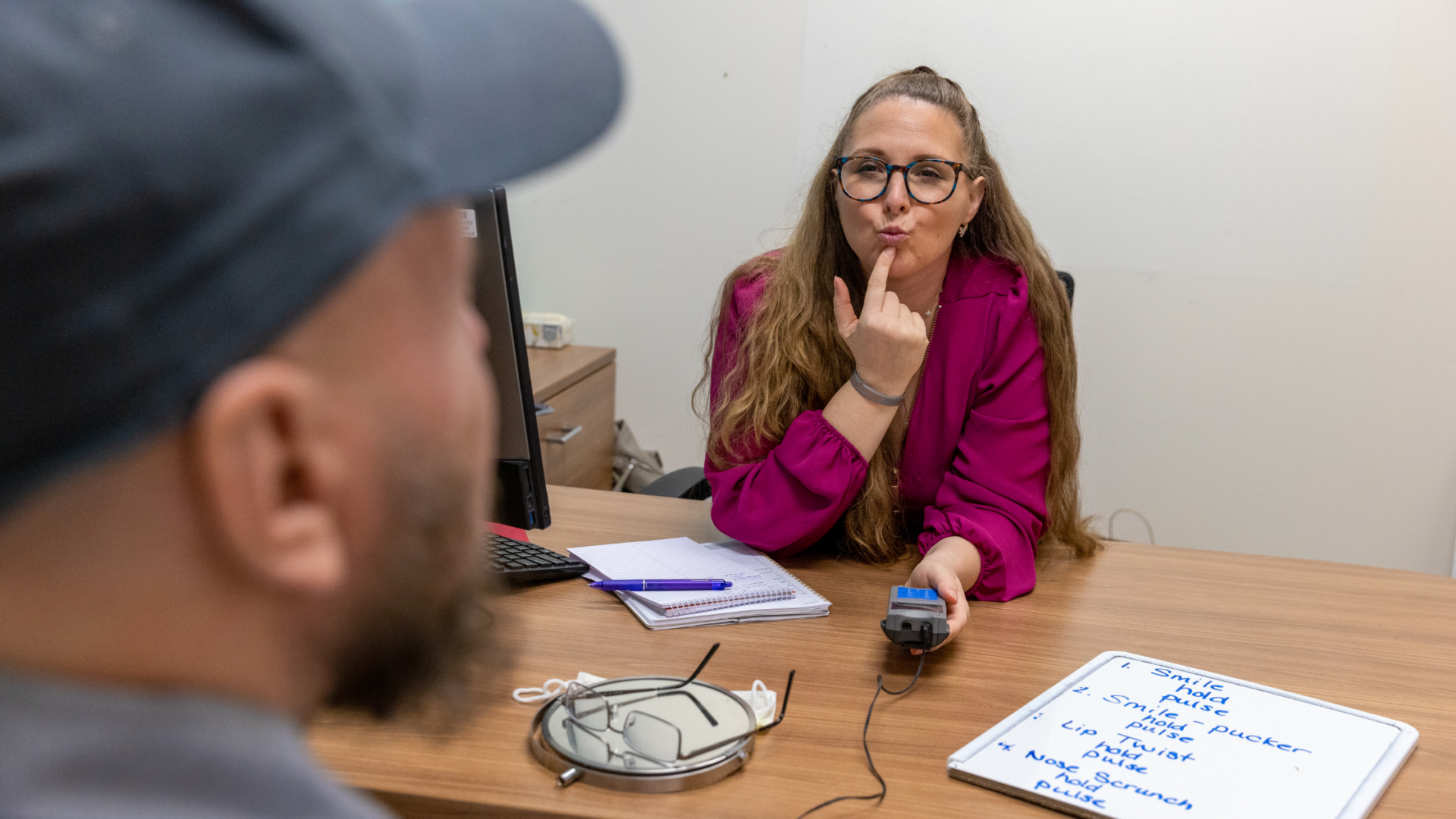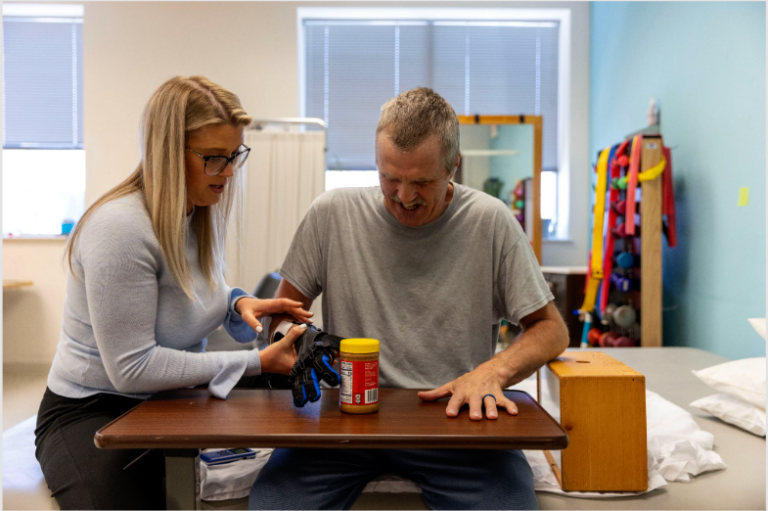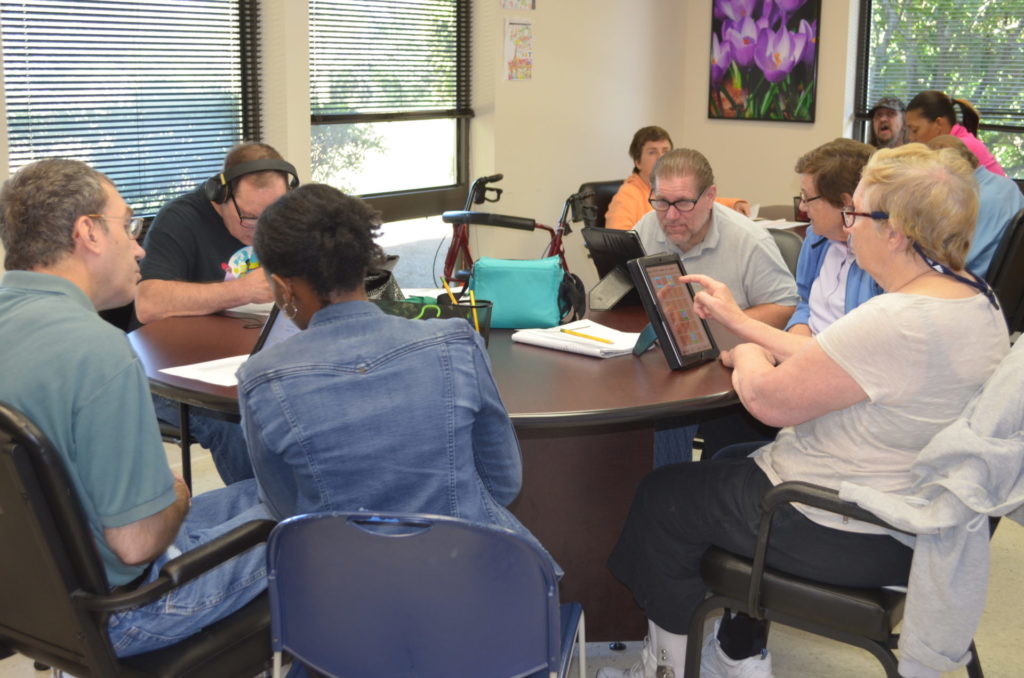Kevin was enjoying his new role as a grandfather of three while working as a machinist, welder, and education trainer in the United States Air Force. His job required him to perform physical tasks with his hands and also speak perfectly while presenting to airmen and women as an instructor.
This all changed in the summer of 2020 when, at 61, he underwent hip surgery. Upon waking up, he learned that he had suffered a stroke on the left side of his brain during the procedure, leading to severe loss of mobility in his right arm and hand, along with difficulty speaking clearly and walking. He spent the next week at Penn’s Stroke ICU before being transferred to Moss Rehabilitation for two months.
Those two months were extremely challenging for Kevin. He couldn’t sleep and experienced painful electric shocks down his right arm when something touched it.


“When you have those kinds of losses, especially in a large part of your brain, you begin to have some depression. However, I was always encouraged by my family and friends, who were my biggest supporters. They taught me to be grateful that I am alive and that I should be grateful to be able to be with my grandchildren.”
For three years, Kevin’s right arm and hand had shown no real improvement. Simple activities—holding a coffee cup, writing poetry, or playing catch with his grandson—were no longer possible. Kevin became frustrated and depressed. Despite the motivation from his therapists, his body wasn’t responding like it was pre-stroke.
“When you are right-handed, and you lose all mobility in your dominant hand after living 61 years with it just fine, it’s very challenging and such a hard adjustment. It is not something you are ok with accepting.”
Introducing Vivistim
In the fall of 2023, Kevin met with a neurologist at Cooper and had a conversation that gave him hope. The neurologist informed him about an innovative new technology designed to enhance upper limb function for stroke survivors during rehabilitation therapy. The treatment involves surgically implanting a Vivistim device—about the size of a pacemaker—into both his left chest and neck. This device stimulates the Vagus nerve, sending electrical pulses to the brain that release neuromodulators essential for learning and memory.
To benefit from Vivistim, Kevin would have to attend three 90-minute weekly therapy sessions with Bancroft NeuroRehab. During these sessions therapists would use a remote to wirelessly activiate the Vivstim device, delivering a gentle pulse to the Vagus nerve during his task-specific occupational therapy sessions. He would also need to continue self-activating the Vivistim device at home by swiping a magnet over the implant during his daily living activities.
“When I first heard about being a possible candidate for this Vivistim Therapy, I can’t tell you how excited I was about the possibility of having feeling back in my arm and hand.” Kevin continues, “Three years of rehab without much movement in my right arm, I was ready for anything.”
Despite the excitement, deciding to proceed with such a cutting-edge treatment was not easy. However, Kevin’s desire to be an active grandfather outweighed any doubts. In March 2024, he underwent the Vivistim implant surgery and began his therapy at Bancroft NeuroRehab shortly afterward.
Life After The Implant
Two weeks after receiving the implant, Kevin started Vivistim Therapy at Bancroft NeuroRehab and at home. The team of therapists conducted evaluations to assess his capabilities with his right hand. Kevin’s therapists encouraged him to set personal goals to guide his therapy sessions and also warned him that the journey could be challenging and painful. Kevin chose three goals: cutting his own food, picking up items without dropping them, and throwing a ball to his grandson.
Jillian, his occupational therapist, shares, “I worked with Kevin since he got his implant, and he would come in from the weekend and tell me, ‘You’ll never believe what I was able to do this weekend!’ I’ve seen his confidence increase week after week as he can do more things with his right arm and hand again. It’s early on in his Vivistim Therapy, but his confidence is the biggest takeaway I have seen.”
Kevin quickly began noticing results. He started regaining feeling in his hand and no longer experienced the painful shocks. Everyday tasks like brushing his teeth, picking up vitamins, and, most importantly, throwing a ball to his grandson were possible again.


“The first time I was able to have the strength and coordination to hold a ball and throw it to my grandson was so joyful. I was so happy. Regaining that kind of ability in your life is such a relief. It’s like a light coming on that I no longer have to be in prison by this stroke and that there is a positive possibility of growing and getting better,” Kevin shares.
Within three months, Kevin had met all of his initial goals. Jillian then worked with him to set new ones: driving, making himself three meals daily, improving his handwriting, and holding his grandson.
“The only thing I can’t do yet, and I’m working on it, is to be able to pick up my grandson! But, that guy is getting so big now, I can hold him with one arm and support him with my other one, but it’s a challenge I’m still working through,” Kevin joked.
Continuing The Journey
After completing his recommended therapy hours with Bancroft NeuroRehab, Kevin met with his neurologist, who his successful recovery from the surgery. Kevin decided he didn’t want his progress to end and chose to continue his therapy with Bancroft NeuroRehab and at home. He practices exercises outside therapy hours using his Vivistim Magnet to stimulate the device.
Three more months of Vivistim Therapy have brought more milestones: regaining the ability to prepare all of his meals independently and reclaiming the ability to drive. These achievements, coupled with the continued support of cutting-edge technology have brought Kevin closer than ever to his pre-stroke life.
“My progress with Vivistim and Bancroft NeuroRehab has been nothing short of miraculous,” Kevin shared.
“Preparing my own food without injury feels like a huge victory!” Reflecting on his recovery, “I would tell myself years ago when I first had my stroke to not be discouraged by the depression that often follows a traumatic brain injury and that it’s a normal reaction.”
“Now I get to look forward to making memories with my grandchildren, like buckling them into their car seats and helping them into rides at the amusement park.”
With Vivistim and Bancroft NeuroRehab, Kevin has reclaimed parts of his life once lost to the stroke. His story is a powerful reminder of resilience and the life-changing impact of stroke rehabilitation technology.


If you or a loved one has suffered from a stroke, don’t let it define you. Follow Kevin’s example of determination and hope. Contact 844-234-8387 or submit an inquiry to start your rehabilitation journey with Bancroft NeuroRehab today.
For resources about stroke, visit the Bancroft NeuroRehab Community Resources page.
To learn more about Stroke, visit our Stroke Rehabilitation page.
Resource Articles


What is Aphasia?
Michelle Valente, M.A., CCC-SLP, Bancroft NeuroRehab Outpatient Program Director and


10 Tips for Supporting a Loved One with Aphasia
Learn practical ways to support a loved one with aphasia


Home Therapy Made Simple: Practical Tips for Stroke Recovery
Recovery doesn’t stop when formal therapy ends. In many ways,









